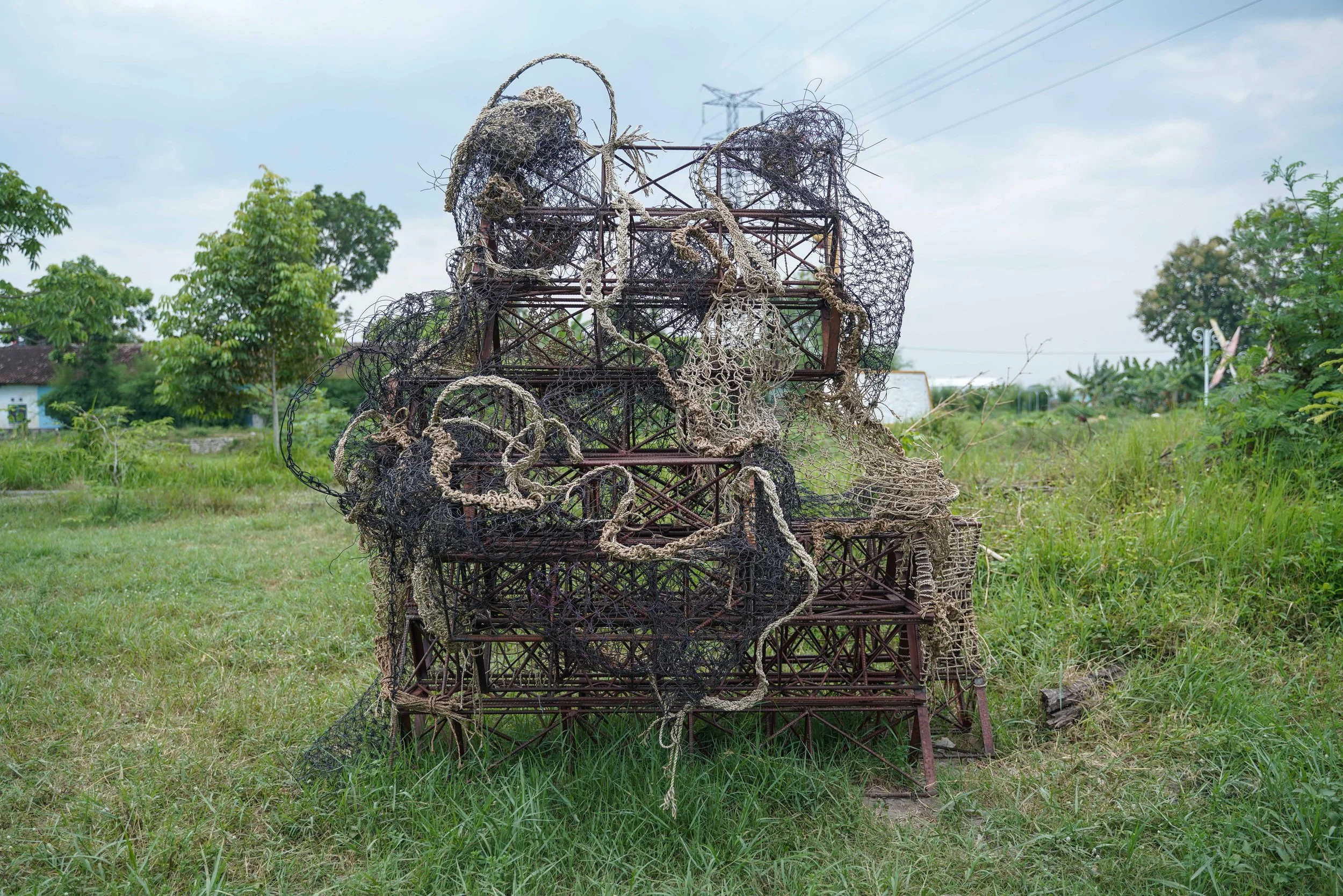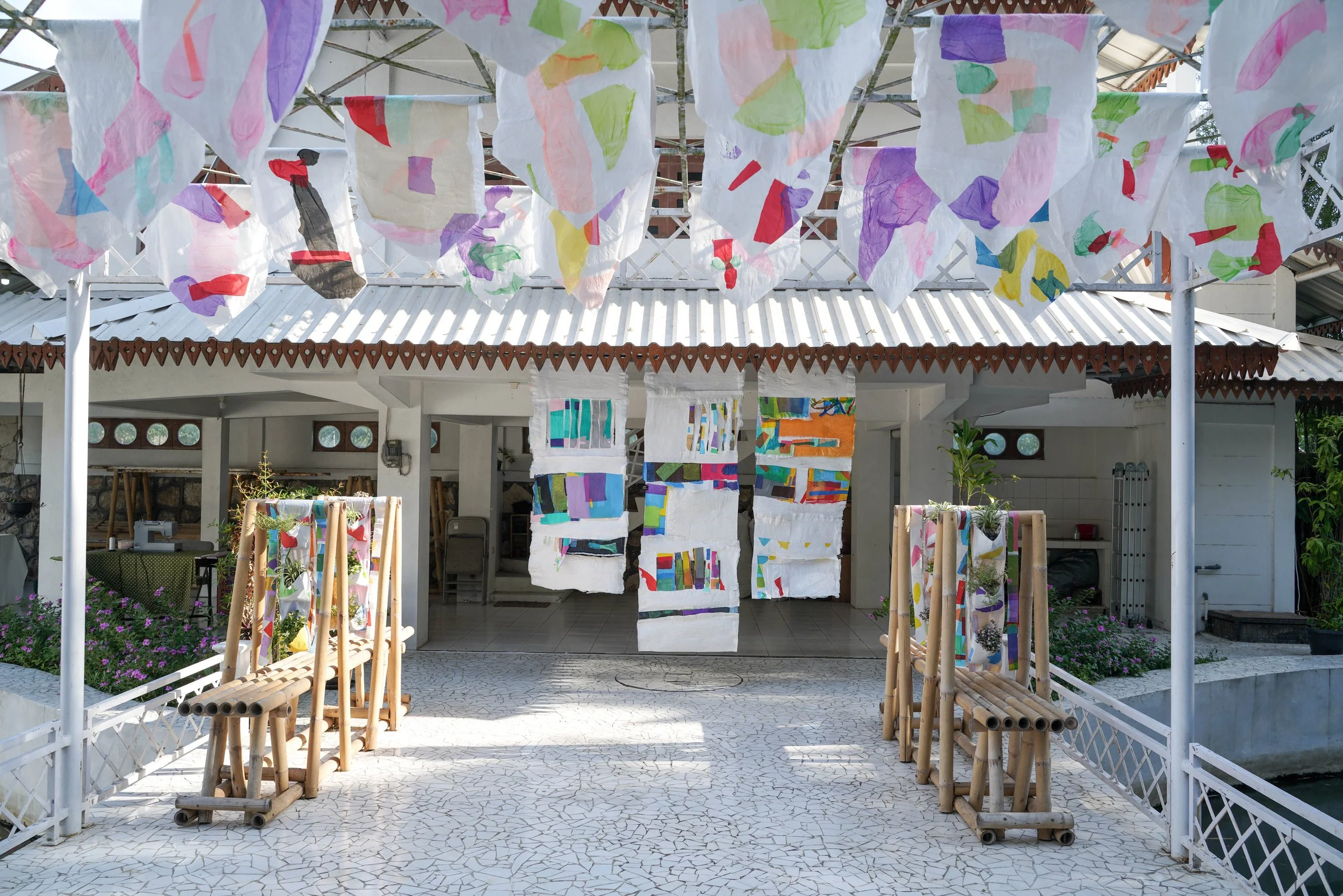Excerpt: Biennale Jogja 18 ‘KAWRUH: Tanah Lelaku’
Artistic practice rooted in local wisdom
Over the years, we have republished parts of long-form writing, from catalogue essays to book chapters. This practice is now formalised as part of our Excerpt series. If you would like to work with us to republish a text, please email us at info@artandmarket.net.
Here is an excerpt from the curatorial introduction written by the Biennale Jogja 18 curators, Bob Edrian, Eva Lin, and ketjilbergerak for the Biennale Jogja 18 KAWRUH: Tanah Lelaku Guide Book.
Agnes Hansella, Sarang, 2025, used cables, mendong rope and pandan rope on an iron frame, 220 x 180 x 250cm. Image courtesy of Jogja Biennale 18.
A practice that transforms into knowledge, Biennale Jogja 18 (BJ18) narrates KAWRUH: Tanah Lelaku as a continuation of the broader Equator Series - Second Cycle, centered on translocality and transhistoricity. Since the beginning of the cycle, which opened two years ago with the theme Titen: Embodied Knowledge–Shifting Grounds, Biennale Jogja has continued to explore artistic networks in the Global South while specifically encouraging efforts toward decentralisation and strengthening decolonial narratives. In engaging with the word kawruh, BJ18 seeks to present diverse readings of knowledge across past, present, and future trajectories, oriented toward experiences and practices that are deeply rooted.
BIYA Project, Lihat Kebunku, 2025, interactive mixed media. Image courtesy of Jogja Biennale 18.
As both a curatorial framework and an imaginative offering for the arts, KAWRUH is anchored in the everyday, in tradition, and in various forms of local wisdom. It serves as a foundation for exploring the meanings of encounter and exchange across cultures with their differing historical complexities. Rooted in Javanese cultural understanding, kawruh means knowledge as the accumulation of experiences critically processed by reason. BJ18 specifically highlights artistic tendencies that are both intrapersonal and interpersonal. These tendencies are situated in dialogical and interdisciplinary forms of work between artists and society (creative practitioners, experts from various disciplines, policymakers, and local communities).
Knowledge as embodied practice and as awareness rooted in local wisdom is, at its core, an effort to live in harmony with nature and the diverse living beings within it. Art—and contemporary visual art in particular—serves as one of the gateways for retracing cultures and knowledges across communities in Indonesia and the Global South. Through dialogue and collaboration with local residents, small communities, and individuals who embody diverse forms of knowledge and local wisdom, artworks become points where the individual, space, and time merge—along with various tensions between village and city, power and social disparity, as well as past and present technologies.
Jessica Soekidi dan Nurohmad, Selaing Bumi Panggungharjo, 2025, clay, mixed media. Image courtesy of Jogja Biennale 18.
The second cycle of the Equator Series framework situates locality and the historicity of the Global South within artistic imaginaries centered on the knowledge of its people. This involves the sphere of village life, which remains closely tied to nature and natural resources, while also encompassing understandings of knowledge and the characteristics of the many elements of the natural world.
An excerpt from the Jayabaya Prophecy of the 11th century and the teachings of Sunan Kalijaga around the 14th century reveal that the time would come when human civilisation, particularly in the Nusantara, would face decline. The phrase “kali ilang kedunge, pasar ilang kumandange” (“the river loses its depth, the market loses its bustle”) carries profound meaning with multiple interpretations. The river, as a source of life, becomes shallower, as does human understanding and knowledge. The market, as a space of encounter and negotiation, loses its liveliness, signifying the disappearance of dialogue and the emergence of various conflicts. This expression, popular in Javanese tradition, illustrates how the transmission of knowledge is key to understanding life, both individually and collectively.
Li Tzu Hsu, Burnt sienna in prussian blue room, 2025, pencil, charcoal, watercolour on paper. Image courtesy of Jogja Biennale 18.
Just as the river holds both a tangible role and a symbolic meaning in human life, so too do the mountains and the sea, which are deeply connected to the constellation of Javanese society, especially in Yogyakarta. As part of the Cosmological Axis or the Philosophy of Yogyakarta, Mount Merapi and the Southern Sea (Indian Ocean) stand as further examples of knowledge manifested through natural elements. The balance and harmony of nature are often projected through the personification of the mountain as father and the sea as mother. Both are revered points as well as centers where the traditions and culture of the local community intertwine.
The sea as the river’s estuary, and the volcano as the source of fertile soil—together, these natural elements form a constellation of collective knowledge preserved across generations. Through an understanding of natural elements, the issues of locality and historical encounters become both conceivable and meaningful. Thus, KAWRUH is projected as a radiance of community knowledge encompassing tradition, wisdom, and local histories that extends outward into broader and more complex social spheres, from local communities to urban, national, and even global contexts.
The organisation of Biennale Jogja 18 designates several sites as axes of this radiance. Divided into two chapters, KAWRUH: Tanah Lelaku Chapter I will take place from 19 to 24 September 2025 in Padukuhan Boro, Karangsewu Village, Kulon Progo, followed by Chapter II in Yogyakarta City, Panggungharjo Village, Bangunjiwo Village, and Tirtonirmolo Village from 5 October to 20 November 2025.
Faris Wibisono, City Roots, 2025, acrylic on canvas, 230 x 130cm. Image courtesy of Jogja Biennale 18.
Chapters I and II involve several village areas as loci for broadcasting the idea of KAWRUH as both a process of self-identification and of growth emerging from within and from one’s closest environment. The chosen villages serve as examples of how knowledge can be unearthed and rediscovered. Artworks, in this context, function as mirrors for both artists and local residents to reflect on their respective journeys, while also serving as bridges to trace forms of knowledge whose transmission may have been interrupted—so that they may once again be experienced and enlivened in daily practice as a response to contemporary challenges.
This moment is expected to spark a shared awareness regarding cultural sovereignty and resilience. It begins with the excavation and activation of local and contextual knowledges that respond not only to local challenges but also to global ones. The village, as a grounding point, stands as the final bastion of sovereignty—rooted in its closeness to natural resources, its deeply embedded ethos of collaboration, and the longevity of its local knowledges. In addition, the spiritual values embedded within village life remain strong, serving as a bond of social cohesion. The encounter between contemporary art and the village positions the artist not only as an artistic agent but also as a partner to the villagers in accelerating the excavation of knowledge long rooted in local culture and tradition. This meeting of village and art is first understood as a mirror. A mirror in the sense that the artwork becomes a medium through which both artists and villagers can view their own positions—often immersed in the richness of their own lived experiences. Art then also functions as a bridge—a medium that connects artists and villagers to knowledge of themselves and their environments: their origins, presence and existence, as well as their purposes and projections for the future. Art thus becomes both a homecoming and a point of departure.
This article is presented in partnership with Jogja Biennale 18.
Jogja Biennale 18 KAWRUH: Tanah Lelaku is on from now until 20 November 2025 in the Yogyakarta area, Bangunjiwo Village, Tirtonirmolo Village and Panggungharjo Village, Special Region of Yogyakarta. For more information, click here.





